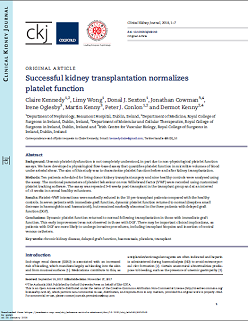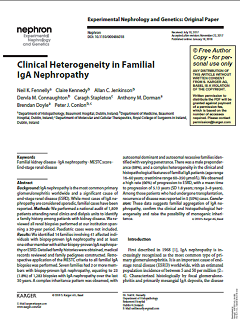The information contained in the publications page are for educational purposes and is not a substitute for a consultation with a physician.

The aim of this study was to characterize platelet function before and after kidney transplantation
Authors: Claire Kennedy, Limy Wong, Donal J. Sexton, Jonathan Cowman, Irene Oglesby, Martin Kenny, Peter J. Conlon and Dermot Kenny
Date: Clinical Kidney Journal, 2018, 1–7

IgA nephropathy is the most common primary glomerulonephritis worldwide and a significant cause of end-stage renal disease (ESRD). While most cases of IgA nephropathy are considered sporadic, familial cases have been reported.
Authors: Neil K. Fennelly, Claire Kennedy, Allan C. Jenkinson, Dervla M. Connaughton, Caragh Stapleton, Anthony M. Dorman, Brendan Doyle, Peter J. Conlon
Date: Nephron-Experimental Nephrology and Genetics: Original Paper, DOI: 10.1159/000486018
Alport syndrome is an inherited renal disease characterized by haematuria, renal failure and hearing loss. Factors that determine progression to ESKD are not well described and it is uncertain whether time to ESKD and mortality have improved over time.
Athors: Kelly YP, Wallis L, Patil A, Murray S, Kant S, Kaballo M, Casserly L, Doyle B, Dorman T, O’Kelly P and Conlon PJ
Date: Journal of Clinical Nephrology and Renal Care, DOI: 10.23937/2572-3286.1510036
We agree that genetic variation outside the HLA region is an important consideration in seeking to understand the pathogenesis of long- term graft survival and potentially identifying novel therapeutic
targets to reduce cumulative allograft loss over time.
Authors: Fuentes MH, Stapleton C ,Cavalleri G , Conlon P, Michael E. Weale, Lord G
Date: American Journal of Transplant. 2018;18:2100–2101.
Improvements in immunosuppression have modified short-term survival of deceased-donor
allografts, but not their rate of long-term failure. Mismatches between donor and recipient HLA play an important role in the acute and chronic allogeneic immune response against the graft.
Authors: Maria P. Hernandez-Fuentes,Christopher Franklin,Irene Rebollo-Mesa,
Jennifer Mollon,Florence Delaney,Esperanza Perucha,Caragh Stapleton,Richard Borrows,Catherine Byrne,Gianpiero Cavalleri,Brendan Clarke,Menna Clatworthy,John Feehally,Susan Fuggle,Sarah A. Gagliano,Sian Griffin,Abdul Hammad,Robert Higgins,Alan Jardine,Mary Keogan,Timothy Leach,Iain MacPhee,Patrick B. Mark,James Marsh,Peter Maxwell,William McKane,Adam McLean,Charles Newstead,Titus Augustine,Paul Phelan,Steve Powis,Peter Rowe,Neil Sheerin,Ellen Solomon,Henry Stephens,Raj Thuraisingham,Richard Trembath,Peter Topham,Robert Vaughan,Steven H. Sacks,Peter Conlon,Gerhard Opelz,Nicole Soranzo,Michael E. Weale,Graham M. Lord,For the United Kingdom and Ireland Renal Transplant Consortium (UKIRTC) and the Wellcome Trust Case Control Consortium (WTCCC)-3
Date: Am J Transplant. 2018;18:1370–1379.
Nephronophthisis (NPH) is the most prevalent genetic cause for ESRD in children. However, little is known about the prevalence of NPH in adult-onset ESRD. Homozygous full gene deletions of the NPHP1 gene encoding nephrocystin-1 are a prominent cause of NPH. We determined the prevalence of NPH in adults by assessing homozygous NPHP1 full gene deletions in adult-onset ESRD.
Authors: Rozemarijn Snoek, Jessica van Setten, Brendan J. Keating, Ajay K. Israni,Pamala A. Jacobson,William S. Oetting,Arthur J. Matas,Roslyn B. Mannon,Zhongyang Zhang,Weijia Zhang,Ke Hao,Barbara Murphy,Roman Reindl-Schwaighofer,Andreas Heinzl,Rainer Oberbauer,Ondrej Viklicky,Peter J. Conlon,Caragh P. Stapleton,Stephan J.L. Bakker,Harold Snieder,Edith D.J. Peters,Bert van der Zwaag,Nine V.A.M. Knoers,Martin H. de Borst,and Albertien M. van Eerde
Date: J Am Soc Nephrol. 2018 Jun; 29(6): 1772–1779.